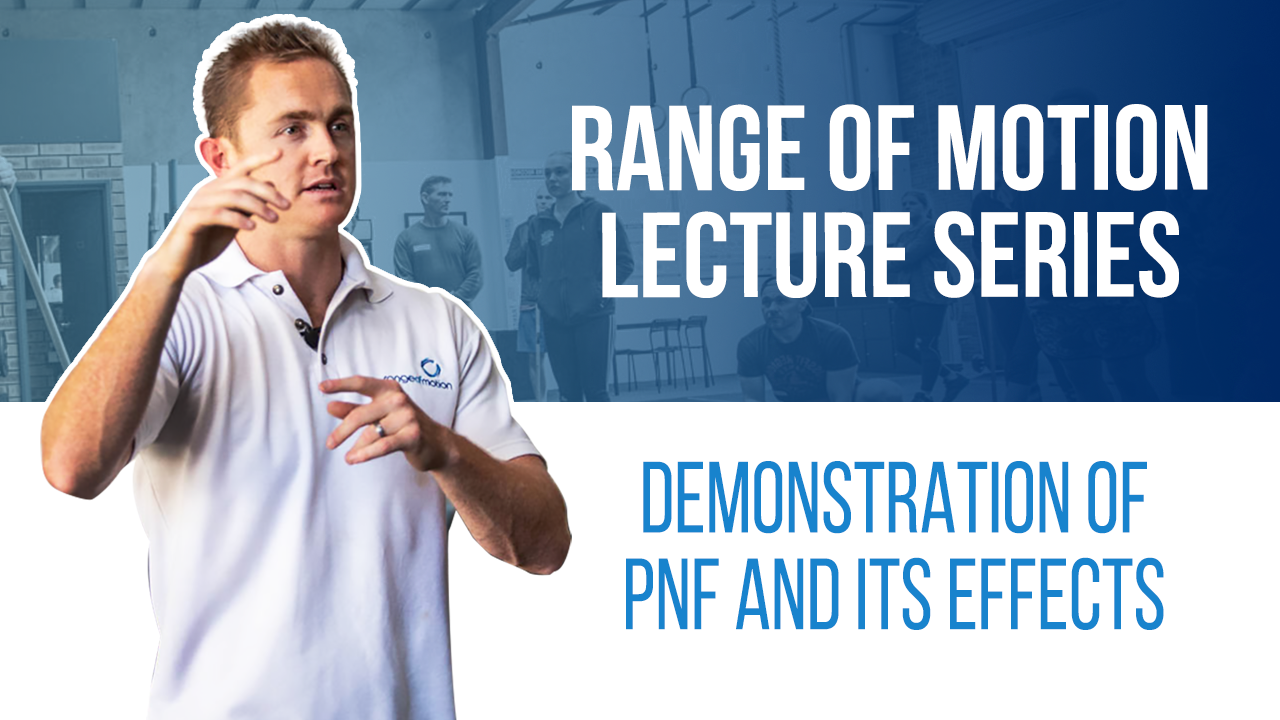Transcribed from video:
– [Instructor] Let’s see if we can improve that flexibility. And we’re going to use this hamstring PNF as an example of how PNF works. And then I’m going to teach you guys how to do this on each other, how to do it on your own, I’m going to show you a whole raft of PNF techniques, you can actually start to implement, so we’re going to go out there and do them in real time. If I go to stretch the hamstring, and I do this and go really fast, what’s this muscle done now?
– [Woman On Table] It’s snapped.
– It’s gone like this, it’s seized up! And it’s tightened up. Why’s it doing that?
– [Woman On Table] Protect it.
– To protect itself! Yeah? It’s called the monosynaptic stretch reflex. Basically what that means, mono is one, synaptic, synapse where two nerves join. And it’s a reflex, so what that means is that you didn’t think as I was stretching you “Oop the hammy’s getting tight! “What I’m going to do? I’m going to contract my hamstring “that way he’s not going to…” There was no thought process. It’s a reflex. As soon as this stretched, a signal went through her spinal cord straight back to the hamstring it didn’t even go to her brain, and said “contract to fight it!” So if you go too quickly into a stretch you get this monosynaptic stretch reflex Boom! Turns the muscle on. Can we stretch a muscle which is contracted? It’s not going to work because remember that’s the purpose of PNF is to create a length in the muscle, a relaxation in the muscle, therefore causing the length. So, the first stage of PNF is to go into a static stretch. And I’m going slowly into that static stretch.
– [Woman On Table] That’s pretty tight.
– Okay? Alright. So we’re holding it there. We’ve gone slowly into that static stretch. If we went too quickly, we would cause that reflex which causes the muscle to tighten up. The same thing is, as a kid you go to the doctor and they tap you with that little hammer just below your kneecap, on your patellar tendon there, and your knee would kick. It stretches and you then go to protect yourself, cause the contraction which causes you to kick your leg. Again, testing your reflexes. So we go slowly into this, hold it for about 20 seconds. The next thing we do is an antagonist contraction. Now, an agonist, this is just fancy names for muscles that do things. An agonist is the muscle we’re talking about, the ant – opposite – agonist is the one on this side. There’s a bit of terminology in this if you can understand it and I will say all these words multiple times in the next half hour. Understand this, it helps. So we’re stretching the hamstring, what we want to do now is contract the muscle on the opposite side. So I want you to pull your leg away from my shoulder. Pull it away, pull it away, pull it away, pull it away. Slide off my hand, you’re going to hold it there for 10 seconds. What’s happening now is this muscle is activated, yeah? Our bodies don’t want co-contraction where everything’s turning on ’cause we’re trying to be efficient. When you contract a muscle on one side of a joint, it actually causes a relaxation of the muscle on the other side of the joint. So if we’re squeezing the quads, it actually relaxes the hamstrings. And then when you relax, look at the change in length. Does that hurt anymore than it did just before?
– [Woman On Table] No.
– ‘Kay, so now we’re just under 90 degrees. It’s like magic, yeah? We couldn’t get that from doing static stretching. So this tells us that once we can get past the neuromuscular stuff, look at this increase in muscle length that we’ve got. Alright? But, there’s more. So now we will hold this for about that 10 or 20 seconds. Just to let that change in length take effect, and just to relax it again. Then we’re going to do the opposite. Now I want you to push down against me. At about 30 percent of your max power. What muscle excuse me is contracting now? And relax. Yeah? Wow. The way that works, if you do that again for me, push down against me, we’re contracting the hamstrings. And there are these freaky little things in your hamstrings called golgi tendon organs. And when you turn those on, they squeeze they squeeze they squeeze they squeeze they squeeze, then they relax. That causes a relaxation in the muscle, and a change in muscle length. Now we’ve taken this a little bit more slowly than we normally would. But, we’ve been doing this for maybe two minutes? Considerable change in length. Can everyone see that? Let’s see how that goes from a me not pushing her into position point of view. Take it up, let’s see how it looks in comparison. Keep this down. So what did we say before about 70? Are we going to agree that that was about there? Not bad, not bad.





